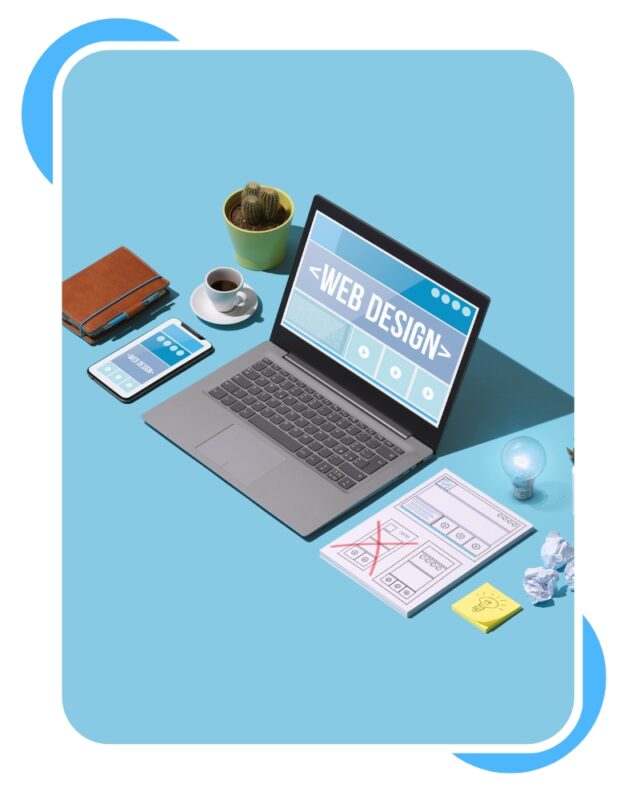
Web design is the process of creating and maintaining websites. It involves various elements such as graphic design, user interface design, and search engine optimization. A good website should have an intuitive layout, use appropriate typography and colour schemes, and be optimized for fast loading times. Additionally, responsive design is crucial to ensure a website is accessible and easily used across different devices. User experience design focuses on creating a positive experience for the user. Lastly, search engine optimization is essential for increasing a website’s visibility in search engine results. Good web design requires a balance of functionality, usability, and aesthetics.

How To Learn Web Design?
Learning web design can be done through various methods, depending on your preference and resources. Here are some options:
Many online courses offer comprehensive web design training, including free and paid options. Some popular online course platforms include Udemy, Coursera, and Skillshare.
Many universities offer web design courses as part of their curriculum. These courses may cover both web design’s technical and creative aspects and may result in a certificate or degree upon completion.
Web design boot camps are intensive training programs that can provide you with practical experience and real-world skills. They can be completed in a shorter period than a university course and may be a good option if you’re looking to acquire practical skills quickly.
Learning web design through self-study can be done through books, tutorials, and online resources. This approach allows for flexibility in learning and can be a more affordable option.
Regardless of your chosen method, it’s essential to practice and apply what you learn to build a strong portfolio and gain practical experience. Networking with other web designers and participating in online communities can help you improve your skills and stay updated with industry trends.

Benefits of Learning Web Design:
There are many benefits to learning web design, including:
Web design is valuable in today’s digital age. With the increasing need for businesses to have an online presence, there is a high demand for skilled web designers.
Web design allows for creativity and self-expression. Designing and building websites will enable you to express your creativity while solving problems and meeting client needs.
Web design can be done remotely and offer flexible work arrangements. This can be especially beneficial for those who prefer to work from home or have a more flexible schedule.
Learning web design can lead to various career opportunities, including working as a freelancer, in-house designer for a company, or in a digital agency.
Knowing web design can also help you create and maintain your website, which can be used to showcase your skills and promote yourself as a professional.
Web design constantly evolves, with new technologies and trends emerging regularly. Learning web design can provide opportunities for continuous learning and professional growth.

Career After Learning Web Design
After learning web design, many career opportunities are available in the field. Some of these career paths include:
A front-end developer implements website design using HTML, CSS, and JavaScript. They work closely with web designers to bring the design to life and ensure the website is functional and responsive.
A UX designer creates a positive user experience on a website. They design the user interface and flow to ensure the website is intuitive and easy to use.
A graphic designer creates visual elements such as logos, images, and illustrations for websites. They work closely with web designers to ensure the website has a cohesive look and feel.
A web content manager is responsible for creating, editing, and publishing content on a website. They may work closely with web designers to ensure visually appealing content.
A digital marketer uses web design and other digital tools to promote a business or brand online. They may be responsible for creating and managing online marketing campaigns, including social media marketing and email marketing.
Learning web design can lead to various exciting and rewarding career paths in the digital industry. With the increasing importance of online presence, the demand for skilled web designers and developers will likely grow.

Salary After Learning Web Design in India
The salary for a web designer in India can vary based on factors such as experience, skills, location, and company size. According to Payscale, the average salary for a web designer in India is around INR 298,000 annually. However, this can range from INR 154,000 to INR 646,000 per year, depending on the abovementioned factors.
Regarding specific job titles, a front-end developer in India can earn an average salary of INR 420,000 annually. In contrast, a UX designer can earn an average salary of INR 650,000 annually. Graphic designers in India can earn an average salary of INR 295,000 annually, and web content managers can earn an average salary of INR 455,000 annually. Digital marketers in India can earn an average salary of INR 395,000 annually.
It’s important to note that salaries vary widely based on factors such as the specific industry, the company’s size and reputation, and the candidate’s experience and skills. Additionally, freelancers and self-employed web designers may have different earning potential than those working for a company.

How to Succeed in a Web Design
To succeed in web design, here are some tips to keep in mind:
Web design is a constantly evolving field, and it’s essential to stay current with the latest design trends, coding techniques, and technologies. Attend industry events, read blogs and online resources, and take courses to stay informed.
Good web design requires a strong sense of aesthetics and principles. Focus on developing your design skills, including typography, colour theory, and layout.
A portfolio of your best work is essential to showcase your skills and attract clients or potential employers. Make sure your portfolio is well-organized, visually appealing, and includes a variety of projects that demonstrate your skills.
Effective communication with clients and team members is crucial to the success of a web design project. Ensure you understand the client’s needs and goals and communicate regularly throughout the design process.
Web design often requires collaboration with developers, content creators, and other professionals. Be open to working with others, and develop strong collaboration skills to ensure the project runs smoothly.
A successful web design requires testing and iterating to ensure the website is functional and user-friendly. Test the website thoroughly and make necessary changes based on user feedback.
To succeed in web design, you need a combination of technical skills, design skills, and communication and collaboration skills. By staying current with the latest trends and technologies, developing a solid portfolio, and practising good communication and collaboration, you can set yourself up for success in web design.
Common Challenges in Learning Web Design
Learning web design can be a rewarding experience, but it also comes with challenges. Here are some common challenges that learners may face:
Web design constantly evolves, and learners must stay updated with the latest trends and technologies. This can be challenging, as it requires ongoing learning and staying informed.
Web design involves both design and coding skills, and learners need to be proficient in both areas to create compelling websites. This can be challenging for those who have more experience in one place than the other.
Web design requires finding the right balance between creativity and usability. Learners may need help finding ways to express their creativity while still creating a functional and user-friendly website.
Learning web design can be time-consuming, and learners must manage their time effectively to balance their coursework with other responsibilities.
Technical issues such as software glitches or server problems can be frustrating and may impede progress in learning web design.
Web design requires creativity and innovation, and learners may need help to stay motivated and inspired throughout the learning process.
Overall, these challenges are common in learning web design. Still, with persistence, dedication, and a willingness to learn, learners can overcome these challenges and succeed in web design.

Advantages and Disadvantages of Web Design.
We will explore the advantages and disadvantages of web design, shedding light on its impact on the online world.
1. Global Reach: Websites can be accessed from anywhere worldwide, making them a powerful tool for businesses and individuals to reach a global audience.
2. Cost-Effective: Compared to traditional forms of advertising, web design is a cost-effective way to promote products and services.
3. 24/7 Availability: Websites are accessible 24/7, allowing users to access information anytime, day or night.
4. Interactive and Engaging: Web design allows for interactive and engaging user experiences, which can help increase user engagement and retention.
5. Measurable Results: Web design offers a variety of metrics and analytics tools that allow users to measure the effectiveness of their website and marketing campaigns.
1. Technical Issues: Technical issues such as website crashes or slow loading times can impact user experience and lead to frustration.
2. Security Risks: Websites are vulnerable to security breaches, which can lead to the loss of sensitive information and damage a company’s reputation.
3. Maintenance: Websites require regular maintenance and updates to remain functional and secure.
4. High Competition: The vast number of online websites means businesses and individuals must compete for visibility and attention.
5. Skill Requirement: Creating and maintaining a website requires technical skills and expertise, which can be a barrier for those unfamiliar with web design or development.

FAQs Related to Web Design
Sure, I would be happy to help! Here are some frequently asked questions related to the Web design:
Here are some frequently asked questions related to web design:
Web design is the process of creating and designing websites. It combines visual design, user experience, and coding to create a practical and functional website.
Web design requires skills in graphic design, user experience design, coding (HTML, CSS, JavaScript), and web development tools and technologies.
Tools commonly used in web design include graphic design software (Adobe Photoshop, Sketch), wireframing and prototyping tools (Figma, InVision), and web development tools (Sublime Text, Visual Studio Code).
The time it takes to learn web design depends on the individual’s prior knowledge and experience, as well as the intensity of the learning program. Some courses take a few weeks, while others take several months or years.
The cost of learning web design can vary widely depending on the type of program or course chosen. Online courses can range from free to several thousand dollars, while university courses and boot camps can cost several thousand dollars.
Salaries for web designers can vary depending on location, experience, and industry. In India, the average salary for a web designer is around INR 3-4 lakhs per year, but experienced web designers can earn significantly more.
Career opportunities in web design include web designer, web developer, UX designer, UI designer, and front-end developer. There are also opportunities to work as a freelancer or start a web design business.
